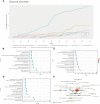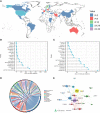Global Research Trends on Infertility and Psychology From the Past Two Decades: A Bibliometric and Visualized Study
- PMID: 35903282
- PMCID: PMC9317298
- DOI: 10.3389/fendo.2022.889845
Global Research Trends on Infertility and Psychology From the Past Two Decades: A Bibliometric and Visualized Study
Abstract
Objectives: The aim of this study was to evaluate the global scientific output of research on infertility and psychology; explore the current status and trends in this field through the cooperation of authors, countries, and institutions; shed light on the direction of clinical infertility research in the future, and provide inspiration for targeted diagnosis and treatment of infertility.
Methods: Research publications on infertility and psychology from the past two decades were retrieved from the Web of Science Core Collection (WoSCC). Bibliometric analyses were performed using VOSviewer software and the bibliometrix R package. Network maps were generated to evaluate the collaborations between different authors, countries, institutions, and keywords.
Results: A total of 151 articles related to the study of infertility and psychology were identified. We observed a gradual increase in the number of publications from 2001 to 2021, and the trend has been relatively stable in the past eight years. Human Reproduction (England), as the leading journal publishing the most papers (29 articles), was cited in the most journals (1208 times). Boivin J was the most prolific author (16 articles), with the largest number of citations (890 times) and the highest h-index (14) during the past decades. Boivin J was also the leader with the highest publication frequency and more active cooperation with other top authors. The United Kingdom (34 papers) and Cardiff University (25 articles) contributed the most publications and were the leading contributors in this field. Active cooperation between countries and between institutions was observed, and analyses of articles and references were also shown. The main hot topics included matters related to women (39 times), in-vitro salt (31 times), infertility (30 times), couples (25 times), and impact (24 times).
Conclusion: Our study results provide a comprehensive overview of the development of scientific literature, allowing relevant authors and research teams to recognize the current research status in this field. At the same time, infertility and psychology may soon become hotspots and should be closely monitored.
Keywords: VOSviewer; bibliometric analysis; hot spots; infertility and psychology; research trends; web of science.
Copyright © 2022 Zhu, Shi, Wang, Cui, Wang, Tang, Qian, Wei, Wang, Zhou and Xu.
Conflict of interest statement
The authors declare that the research was conducted in the absence of any commercial or financial relationships that could be construed as a potential conflict of interest.
Figures









Similar articles
-
Global Research Trends on Prostate Diseases and Erectile Dysfunction: A Bibliometric and Visualized Study.Front Oncol. 2021 Feb 12;10:627891. doi: 10.3389/fonc.2020.627891. eCollection 2020. Front Oncol. 2021. PMID: 33643922 Free PMC article.
-
Global research trends of acupuncture therapy on cancer pain: A bibliometric and visualized study.Front Oncol. 2023 Mar 6;13:1077961. doi: 10.3389/fonc.2023.1077961. eCollection 2023. Front Oncol. 2023. PMID: 36950556 Free PMC article.
-
Global Highly Cited Publication Trends and Research Hotspots in Osteoporosis and Bone Metabolic Cells: A Bibliometric and Visualization Analysis from 2013 to 2023.Endocr Metab Immune Disord Drug Targets. 2025;25(5):386-399. doi: 10.2174/0118715303300989240702043834. Endocr Metab Immune Disord Drug Targets. 2025. PMID: 39005119
-
Mapping the Evolution of Digital Health Research: Bibliometric Overview of Research Hotspots, Trends, and Collaboration of Publications in JMIR (1999-2024).J Med Internet Res. 2024 Oct 17;26:e58987. doi: 10.2196/58987. J Med Internet Res. 2024. PMID: 39419496 Free PMC article.
-
Bibliometric and visualized analysis of ocular drug delivery from 2001 to 2020.J Control Release. 2022 May;345:625-645. doi: 10.1016/j.jconrel.2022.03.031. Epub 2022 Mar 20. J Control Release. 2022. PMID: 35321827 Review.
Cited by
-
Correlations among hope, fertility quality of life and negative emotions for couples undergoing their first in vitro fertilization-embryo transfer: a cross-sectional analysis.Reprod Health. 2025 Jan 28;22(1):10. doi: 10.1186/s12978-025-01954-x. Reprod Health. 2025. PMID: 39876018 Free PMC article.
-
Using chord diagrams to explore article themes in 100 top-cited articles citing Hirsch's h-index since 2005: A bibliometric analysis.Medicine (Baltimore). 2023 Feb 22;102(8):e33057. doi: 10.1097/MD.0000000000033057. Medicine (Baltimore). 2023. PMID: 36827008 Free PMC article.
-
Predictors and incidence of depression and anxiety in women undergoing infertility treatment: A cross-sectional study.PLoS One. 2023 Apr 13;18(4):e0284414. doi: 10.1371/journal.pone.0284414. eCollection 2023. PLoS One. 2023. PMID: 37053254 Free PMC article.
-
Scientific landscape and visualization analysis of the link between adenomyosis and infertility from 2000 to 2024.Front Med (Lausanne). 2025 Feb 19;12:1488866. doi: 10.3389/fmed.2025.1488866. eCollection 2025. Front Med (Lausanne). 2025. PMID: 40046932 Free PMC article.
-
Understanding the Male Perspective: Evaluating Quality of Life and Psychological Distress in Serbian Men Undergoing Infertility Treatment.Life (Basel). 2023 Sep 11;13(9):1894. doi: 10.3390/life13091894. Life (Basel). 2023. PMID: 37763298 Free PMC article.
References
-
- Centers for Disease Control and Prevention . Key Statistics From the National Survey of Family Growth-I Listing (2019). Available at: https://www.cdc.gov/nchs/nsfg/key_statistics/i_2015-2017.htm#infertility.
Publication types
MeSH terms
LinkOut - more resources
Full Text Sources
Medical
Miscellaneous

